Scratch Twin Shuttle Original Design / Scratch Built
Scratch - Twin Shuttle {Scratch}
Contributed by Mark Fisher
| Manufacturer: | Scratch |
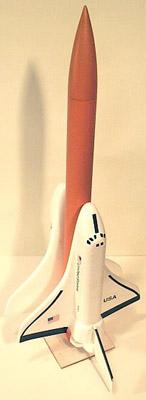
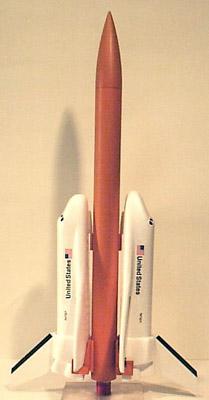 Brief:
Brief:
Parachute-recovered core, two large gliders
Construction:
This twin uses the Space Shuttle foam gliders originally from Comet, but now
distributed by Guillows. I replaced the thin (0.088") foam rudders with
3/16" balsa and the plastic insert used for rubber band launching with
1/8" dowel mounted to a 3/32" balsa spar. These dowels mate to a pair
of 1" long 1/8" Estes launch lugs on the core, while the wings rest
in a cradle made from 2" aileron material and 3/32" plywood
"clips". The core is an 18" length of BT-60 with a standard 24
mm motor mount, and recovers on an 18" nylon parachute.
Needless to say, any serious software modeling of this bird was out of the question, though I did do some rough approximations. The gliders are amazingly light, massing right at one ounce, even with my mods. Still, she didn't have much margin, and was probably going to require some nose weight. I added an ounce of clay, but even with that, she's still less than six ounces dry, which means a three second delay is required. I did set up the motor mount so it can run the E11 reload, but its probably not a good motor for her. I thought Estes' new C11 might work too, but it only gets her to about 150 feet. I checked other motors, too, but this is pretty much a one-trick pony on the Estes D12-3.
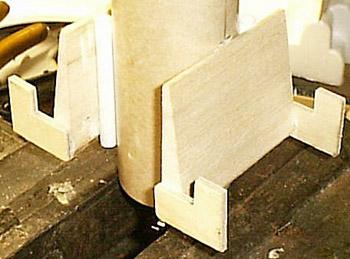 I finished the core in Krylon
Popsicle Orange (2410), followed by Testors Dull Coat (1260) to give the
appearance of a stretched main (or should I now say "central") tank.
I painted the gliders' rudders with Kilz white-pigmented spray sealer, and
added the decals that came with the glider kits. In honor of the two Shuttles
that no longer fly, I call one Enterprise (the stub-nosed one) and the other
Challenger, though I haven't put their names on them yet.
I finished the core in Krylon
Popsicle Orange (2410), followed by Testors Dull Coat (1260) to give the
appearance of a stretched main (or should I now say "central") tank.
I painted the gliders' rudders with Kilz white-pigmented spray sealer, and
added the decals that came with the glider kits. In honor of the two Shuttles
that no longer fly, I call one Enterprise (the stub-nosed one) and the other
Challenger, though I haven't put their names on them yet.
Flight:
Her first flight was at Danville prior to paint, and she performed flawlessly.
I didn't pay much attention to how I set her up, and put the wings parallel to
the wind. As a result, she weathercocked quite a bit, but it didn't seem to
hurt. The D12 ejected right after apogee, the gliders separated without a hitch
and wobbled around in slow, lazy spirals. The core beat them to the ground by a
good bit, as it should be. Her next flight was on a windier day, and she
weathercocked pretty badly again. The gliders separated beautifully at
ejection, just as before, but the strong winds kept them from gliding as well.
They came down with the core, one inverted and one nose down. No damage,
though, I'd just have to fly her were the winds aren't so bad.
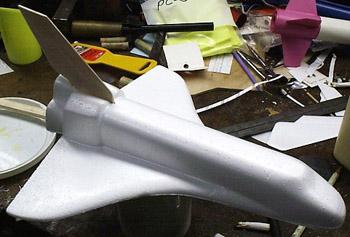 Her third flight was in
slightly better winds, but she encountered some serious problems, nonetheless.
She weathercocked and was going at the usual speed at ejection. The 'chute
tangled on one of the wing cradles, and she recovered hard, breaking off one of
the clips. The gliders faired no better, both landing on pavement, with
Challenger sustaining a big dent on one side of her nose. Still, nothing that
wasn't repairable, and I thought I'd keep her in the box until I had calmer
conditions. I couldn't do it, though, and after repair I flew her on another
windy day. This time I got her aligned properly and boost-out was relatively
straight, i.e., no worse than any other that day. She snapped her shock cord,
the body recovered ballistically, and the nose cone wound up about a 1/4 mile
away, despite the nose weight. No damage to the core and the gliders flew and
recovered fine, so a quick fix with some Rogue 300# Kevlar®
put her back on the pad. After those repairs, she went in light winds.
Her third flight was in
slightly better winds, but she encountered some serious problems, nonetheless.
She weathercocked and was going at the usual speed at ejection. The 'chute
tangled on one of the wing cradles, and she recovered hard, breaking off one of
the clips. The gliders faired no better, both landing on pavement, with
Challenger sustaining a big dent on one side of her nose. Still, nothing that
wasn't repairable, and I thought I'd keep her in the box until I had calmer
conditions. I couldn't do it, though, and after repair I flew her on another
windy day. This time I got her aligned properly and boost-out was relatively
straight, i.e., no worse than any other that day. She snapped her shock cord,
the body recovered ballistically, and the nose cone wound up about a 1/4 mile
away, despite the nose weight. No damage to the core and the gliders flew and
recovered fine, so a quick fix with some Rogue 300# Kevlar®
put her back on the pad. After those repairs, she went in light winds.
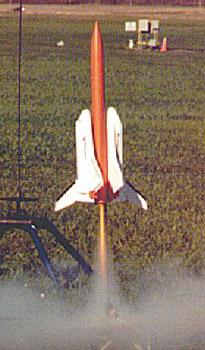 My buddy's Flat Cat had just
flown a spectacular glide, and I was afraid that the Twin Shuttle would
disappoint when compared to it, but she surprised me by boosting straight and
ejecting right at apogee. The center "tank" came down between the LCO
table and the pads, and as everybody watched it come in, Enterprise banked in
over their heads for a perfect touchdown feet from it. Challenger wound up
about 75 yards away, but also had a perfect landing. Finally, success. As I
carried the pieces back to my prep table, folks were telling me I should
upscale it about three or four times. Ha! Her sixth effort was also in higher
winds than I would have liked, but I put her on the pad with the rudders
parallel to it and she flew pretty well. She even executed a little "roll
program", turning the rudders perpendicular to the wind right after she
left the rod, but then stabilized and flew straight thereafter. Ejection at
apogee was at almost zero speed due to the small amount of weathercock. The
pieces all drifted a good 150 yards, but landed within a few dozen feet of each
other. When she flies right, this bird always impresses.
My buddy's Flat Cat had just
flown a spectacular glide, and I was afraid that the Twin Shuttle would
disappoint when compared to it, but she surprised me by boosting straight and
ejecting right at apogee. The center "tank" came down between the LCO
table and the pads, and as everybody watched it come in, Enterprise banked in
over their heads for a perfect touchdown feet from it. Challenger wound up
about 75 yards away, but also had a perfect landing. Finally, success. As I
carried the pieces back to my prep table, folks were telling me I should
upscale it about three or four times. Ha! Her sixth effort was also in higher
winds than I would have liked, but I put her on the pad with the rudders
parallel to it and she flew pretty well. She even executed a little "roll
program", turning the rudders perpendicular to the wind right after she
left the rod, but then stabilized and flew straight thereafter. Ejection at
apogee was at almost zero speed due to the small amount of weathercock. The
pieces all drifted a good 150 yards, but landed within a few dozen feet of each
other. When she flies right, this bird always impresses.
Summary:
Ever since I saw a pic of George Gassaway's twin boost glider in Sport Rocketry
that utilized a pair of Turbo Jet 2000 two foot wingspan straight-wing foam
gliders from Life-Like I've wanted to do one like it. This is a rather fitting
tribute, as George is best known for his awesome Shuttle models. While she
flies great, orientation on the pad is critical. These kinds of gliders are
really designed for bungee launching and landing before terminal velocity is
reached, so Flat Cats they ain't. A little more nose weight for them would
help, as the upper pin is much lighter than the plastic insert it replaces. I
don't like building rockets that only use one motor type, for that puts it at
the mercy of a single manufacturer. Still, she was pretty easy to build, looks
neat as heck, and with a little attention can perform wonderfully.
Sponsored Ads
 |
 |











